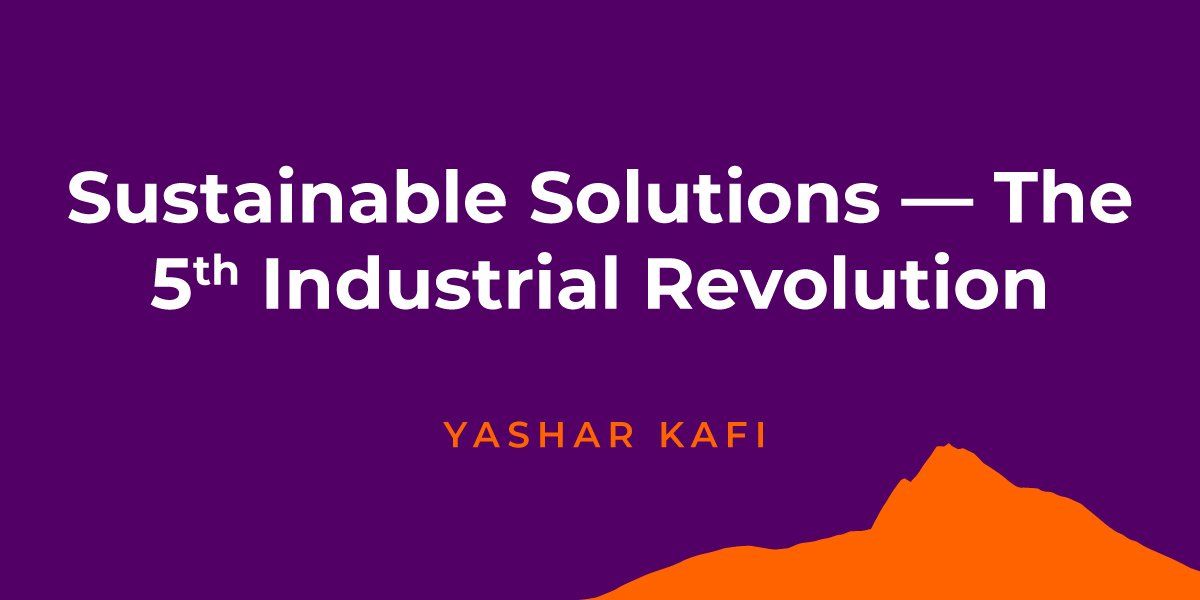Sustainable Solutions — The 5th Industrial Revolution
First came the steam engines, astounding inventions that officially launched the first industrial revolution and paved the road leading to the second industrial revolution, which saw advancements in electricity, combustion engines, and steel processing.
Continuing the evolution was the third industrial revolution, which saw the arrival of automation and computing, which laid the computer-driven foundation for our current fourth industrial revolution, marked by advances in artificial intelligence, robotics, the Internet, blockchain, digital currencies, and so much more.
Taking the Fifth…
We now find ourselves at the threshold of the fifth industrial revolution, but are we ready to take the leap? It’s become painfully clear that the world can no longer make and manufacture products in the same way it has been: It’s simply not realistically sustainable. For this reason, organizations must adapt—and fast—becoming more responsible in their use of resources and best practices to succeed in “taking the fifth” by storm.
We believe that intelligence has made accomplishing this easier than ever before and has even reduced the need for trade-offs or setting for inferior products or results in the process. As we stand on the precipice of the fifth industrial revolution and look to jump in, we at AMPlify believe that the move toward sustainability and intelligence will be the defining features of this next phase.
What’s Next?
With digital thread capabilities that allow for the digitization of entire product and operating value chains, leaders can now find sustainable solutions that are also responsible, economical, and relevant. So, what can we expect from the fifth industrial revolution?
Sustainable Solutions
Using history as an indicator, where each resulting revolution built upon the technology and advances introduced in its predecessor, we can confidently predict that as we move into the fifth industrial revolution, AI will take center stage. But it will become a 2.0 version, if you will, as we harness all of its potential while merging it with more environmental, social, and governance (ESG) efforts, all of which adhere to tightening regulations and consumer demand for sustainable responsibility—and accountability—in companies and brands.
Net Zero Industry Transitions
The time to act is now, and talk is cheap. Net-zero carbon targets alone are no longer acceptable. Instead, making these targets realities reached is the name of the game. By using the advances in digitization to improve and transform business models, these targets can be met, sustainability milestones.
Improved IT and Technologies
While digital technology is a superhero of support for sustainability, the energy it sucks up to do so is staggering. The solution for this will come as technology itself is used more sustainably, and then that improved technology will become the channel for furthering the movement itself.
Circular Value Chains
Pivoting to responsible and circular value and supply chains will bring us one step closer to our sustainability ideals. This type of supply chain ushers in a completely new way of conducting business by empowering organizations to come together and innovate in ways that still turn a profit while respecting our Earth.
Measuring Up
Measuring our sustainability is accountability. It forces us to take a hard look at data and see where we are at and what needs to continue to be improved. The bottom line is: For sustainability to truly become a reality for your business, it must become a top priority that drives your targets and how you report data. Numbers don’t lie, and keeping proper track can help keep you honest.
Creating a Culture
Committing to sustainability is not just one oath a company takes and then never thinks of it again. Instead, your commitment to sustainability has to be interwoven in everything you do. You must create a culture that lives and breathes sustainability. You’ll be amazed at how adopting this mindset and practice will transform your company from the inside out.
Consumer Satisfaction
More than ever, consumers are demanding that companies place sustainability as a top priority. This coming revolution will see companies giving the customers what they want by refusing to compromise and adopting best practices that honor the Earth. After all, the customer is always right.
In light of all of these exciting things coming, I’d say that the fifth industrial revolution is exactly what we need. As you forge ahead into the fifth, AMPlify is here to support you in every way. Reach out today and let us help get you started.




